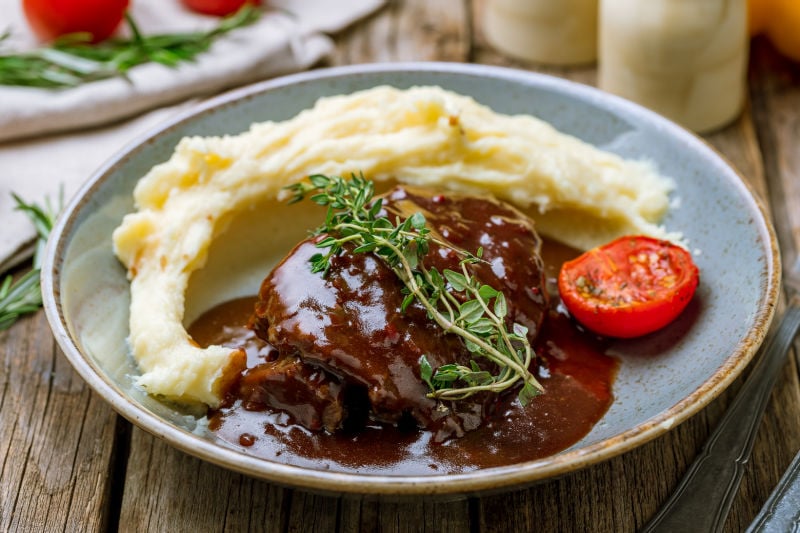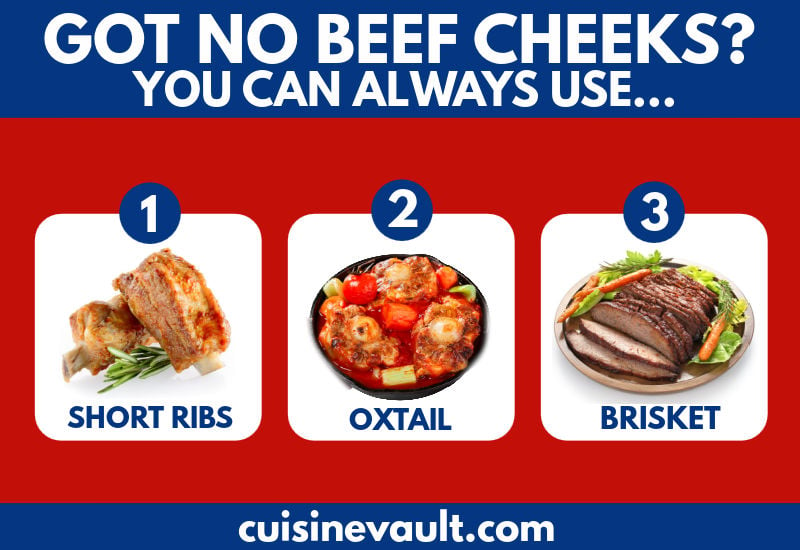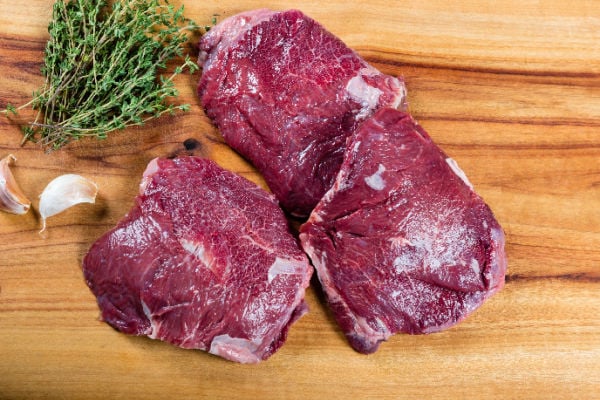Is There Another Name for Beef Tongue

Beef cheeks are sliced from the cow's cheek muscle and they're tough and sinewy before cooking. Once slow-cooked, they become melt-in-your-mouth tender, with a deliciously rich, beefy flavor.
If you've got no beef cheeks, there are plenty of other beef cuts that will work just as well. We've pulled together our favorite beef cheek substitutes for your next meal.
Table of Contents
- What can I use to replace beef cheeks in recipes?
- Frequently asked questions
- Summing up
What can I use to replace beef cheeks in recipes?
If you need a substitute for beef cheek in your next dish, try beef short ribs, oxtail, brisket, or Osso Bucco. While each cut has slight differences, they share a similar hearty flavor and tender texture. Best of all, they're cheap cuts that any home cook can transform into a restaurant-class meal.
1. Beef short ribs
Beef short ribs, also known as flanken ribs, are sliced from under the cow's chuck. They're marbled with fat and once cooked, become tender and full of beefy flavor.
The meat is thinly cut across the rib section which means that 3-4 sections of bone come attached. This differs from beef cheeks which are boneless. If you don't like bones then this won't be the best option for you, but keep in mind that they'll help keep the meat tender and reduce the chance of overcooking.
If you don't have time to slow cook short ribs then we suggest marinating to help tenderize the meat.
Alternative names for short ribs: crosscut ribs, Korean short ribs, English short ribs, or braising ribs.
2. Oxtail
Oxtail is sliced from the cow's tail and makes a handy replacement for beef cheek. Laden with cartilage and fat, the tail is full of beef flavor and becomes incredibly tender once slow-cooked.
The tail comes with an added bonus, marrow. People that don't want to eat marrow may want to try a different alternative. Also, if you don't like dealing with bones then avoid it.
3. Brisket
Brisket is a fatty cut of meat from the lower chest or breast of the cow. For all the "bone-haters", brisket is probably your best choice. It is a luscious, slightly chewy type of meat that can be sliced or shredded. Perfect eaten with creamy mash or added to pasta or tacos.
The biggest difference between beef cheeks and brisket is how they're sold. Brisket comes in one large, solid piece whereas cheeks are sold in individual serves. For most, this won't be a deal-breaker though.
4. Osso Buco
Osso Bucco is a popular cut of meat from the veal's shin bone. Meaning 'hollowed bone' Osso Bucco is another tender variety of meat that falls apart once cooked over a long period in a sauce.
If you use veal, you'll find it has a different flavor. Good quality veal is usually more tender than beef with a less intense beefy flavor. People that enjoy milder tasting food will appreciate what Osso Bucco has to offer.
Just remember, it has marrow, which you can always set aside if you don't enjoy it.

5. Chuck
Chuck is an affordable variety of meat that is easy to find. Perfect braised, it's a tough, collagen-packed cut from the cow's upper arm and shoulder. After cooking, you get tender meat that is full of flavor.
Your best options for cooking chuck include slow-cooking, pot roasts, and stews. It makes an excellent lookalike Golden Corral Pot Roast. Some people enjoy grilling this meat but watch it closely as it will become dry and tough if left too long on the heat.
6. Silverside
Silverside is commonly used to make corned beef, but you could use it to replace beef cheeks if you're in a pinch. You'll find silverside doesn't have as much beef intensity and it's saltier. Also, it's much leaner with a wide-grained texture.
Anyone looking for a cheaper dinner may want to consider silverside. You won't have to deal with any bones and it's delicious served with a mustard parsley sauce.
7. Lamb shanks
If you don't enjoy beef then try lamb shanks. Their rich, luxurious depth of flavor is hard to beat. They're often served in high-end restaurants for a much higher price than it'll cost you to make them at home.
8. Beef tongue
Beef tongue won't be for everyone's palate, but it's a good backup option if you haven't got any beef cheeks. Although both these cuts are from the same part of the cow, you'll find the tongue is a little milder. It's also tougher, so if you want the tenderness of cheeks, slow cook the meat.
Related reading:
How do I replace skirt steak in cooking?
What can I use as an alternative to beef consomme?
What are some useful liquid smoke alternatives?
Frequently asked questions
Where do beef cheeks come from?
Beef cheeks are a tough cut of meat taken from the cow's cheek muscle. As the cow spends so much time chewing grass and cud, the cheek is tough and sinewy until cooked.
Are beef cheeks fatty?
The beef cheek is lean and sinewy in texture. While many types of lean meat aren't usually tender, beef cheeks are both lean and tender, making them a prized cut.
What does beef cheek taste like?
Beef cheeks are packed with rich, beefy flavor; they're closer to the gamey end of the spectrum rather than a mild, traditional steak flavor.
Are beef cheeks expensive?
Beef cheeks will vary in price depending on the country and whether the cow was grass-fed, hormone-free, wagyu, etc. In the United States, the average price is around $10-15 per pound. In restaurants, you'll pay considerably more.
What are beef cheeks used for?
Beef cheeks are best slow-cooked in liquid to help break up the collagen. They are well-suited to stews, pot roast, curries, or braises. Try making beef cheek ragu or cooking them on their own with Guinness, then serving with a demi-glace sauce or gravy.
Why are my beef cheeks tough?
Beef cheeks need time to break down the meat fibers. If you have unpleasant, tough cheeks then they probably need to be cooked on a lower heat for longer. A slow cooker will help you make perfectly tender cheeks every time.

Raw beef cheeks on a chopping board with herbs.
Summing up
When cooked the right way, beef cheeks make for a mouth-watering dinner. But not everyone likes the idea of eating a cow's cheek; others may find them hard to find in their part of the world.
If you need a substitute for beef cheeks then use beef short ribs, oxtail, brisket, or Osso Bucco. They all offer meaty, beef flavor and are extremely moist and tender.
For those wanting a non-beef replacement, try lamb shanks. Good quality shanks are full of flavor and the meat falls off the bone when they're served up.
Source: https://tastylicious.com/substitutes-for-beef-cheeks/
0 Response to "Is There Another Name for Beef Tongue"
Enregistrer un commentaire